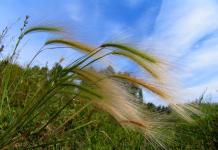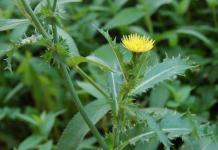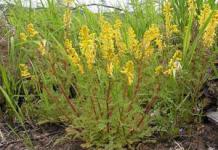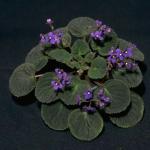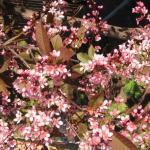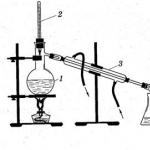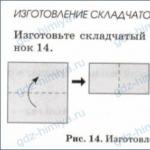In the cold regions of Russia, not every plant can survive, but steppe almonds do not belong to them. The shrub is distinguished by extraordinary winter hardiness. Not only frost resistance was included in the list of advantages of this low plant.
Steppe almond is a beautifully flowering shrub that will be the best decoration for your garden.
The steppe almond or bean tree looks like a pink cloud has descended from the sky: many flowers of different shades adorn its shoots on flowering days.
Character traits
The Latin name of the plant is Amygdalus nana, it is also known as low almond or beaver.
Its homeland is the steppes, forest edges and slopes of ravines in Siberia, Asia and Eastern Europe. Gradually, from the wild, a rare handsome man began to be planted in gardens.
- The height of the shrub is about 1.5 m. The crown is neat, ovoid or spherical in shape.
- The bark is brown, often with red tints.
- The root system is fragile.
- The leaves are long, but narrow, leathery, rich green.
- The flowers are 2-3 cm in diameter, the flowering of the tree lasts about a week. This almond resembles sakura.
- Fruits are ovoid, up to 2 cm long, ripen by the beginning of autumn. The fruits are rich in vegetable oils, which are used for cosmetic purposes, and the kernels are added as a spice to meat dishes, but eating them raw is dangerous to health.

Eating raw fruits of steppe almonds is dangerous for health
The decorative virtues and characteristics of the almond have made it attractive to hundreds and thousands of gardeners. Agronomists have created new varieties based on it, which are distinguished by larger flowers or other colors.
Steppe almonds are suitable for cultivation on almost any, including very poor, soils, in cold or arid regions and on the territory of industrial cities.
Correct fit
Planting and care are activities in which every little thing is important. Steppe almonds are planted either in autumn or in spring. The best site for growing shrubs is sunny and open, fertile soil is desirable, although it grows on poor lands, only its flowering will be paler. Landing is carried out in several stages:
- Make a landing hole, the width and depth of which should fit the roots. Drive a pole for support.
- Cover the bottom with a thick drainage layer, and sprinkle it with a thin layer of sand on top.
- Gently straighten the roots and place them in the hole, then cover them with earth to such a level that the neck remains outside.
- Moisten the earth abundantly with a bucket of water, and when it is absorbed and the soil settles, tie a low almond to a support.
- Mulch with dry leaves.

After the planting of steppe almonds, the ground must be mulched with dry foliage
care requirements
Low almonds are a profitable investment for summer residents. Well-groomed shrubs with a pleasant aroma and pink foam of flowers will turn any area into a marvelous garden. Low almond or beaver is unpretentious in care and requires as much care as other garden plants.
- It needs moderate watering once a week, and on dry days and during the flowering period, it needs to be watered more often.
- Weeds will easily destroy the plant, so the trunk circle should be weeded regularly.
- Top dressing in spring and autumn strengthens the health of the shrub, prepares it for wintering and supports flowering.
- An overgrown crown prevents the tree from enjoying the sunlight. Every spring, dry and frost-damaged branches are removed. The second pruning is carried out after flowering.
- When growing shrubs, preparation for winter occupies an important place. Young fragile plants are insulated with straw, and older trees easily survive frosts without shelter.
Diseases and pests
- Aphid is a pest that feeds on greens and infects shrubs with various sores. The insect reproduces quickly, so measures against it must be taken immediately. Infusions made from dandelion or potato tops work well against aphids.
- Gray rot is a fungal disease that manifests itself in the form of brown spots on the leaves. After rain, the spots are covered with white bloom - a cloud of spores that the wind quickly spreads throughout the garden and infects other trees on the site. Fungicides, which can be purchased at specialized gardening stores, help against the disease.
- Clusterosporiasis. The disease is activated and spreads faster in wet weather, and its symptoms are numerous spots on leaves and fruits. Fungicidal preparations help to cope with clasterosporiosis.
Preventive measures will protect the almonds from death: spraying with Bordeaux mixture and cutting. The main cause of diseases is improper cultivation.
Abundant watering provokes the development of fungal diseases, so shrubs should not be watered too often. Stains, wilted leaves, and other external symptoms may indicate a lack of nutrients in the soil.
The basic rules for the disease: pruning and destruction of the affected branches, digging up the site, cleaning last year's foliage, in which pests could hide.
| Almond low | |
| |
|
| scientific classification | |
|---|---|
| Kingdom: |
Plants |
| Department: |
flowering plants |
| Class: |
Dicotyledonous |
| Order: |
Rosaceae |
| Family: | |
| Subfamily: |
Plum |
| Genus: | |
| Subgenus: | |
| View: |
Almond low |
| International scientific name | |
|
Prunus tenella Batsch, 1801 |
|
| View in taxonomic databases | |
| CoL | |
Almond low, or steppe, or dwarf(lat. Prunus tenella, syn. Amygdalus nana) is a shrub plant of the rose family ( Rosaceae).
Description

Shoots with flowers
Low, sometimes creeping shrub up to 1-1.5 m tall with ascending bare branches and numerous shortened lateral branches. On annual shoots, the bark is whitish or reddish-brown, on perennial shoots it is reddish-gray or gray. Gives root offspring and often forms thickets. Stipules entire, up to 10 mm long, falling off early. The leaves are narrow, linear-lanceolate or lanceolate, shiny, serrate-toothed along the edge, 2.5-6 cm long, 0.5-2.5 cm wide, pointed at the apex, with a base gradually narrowed into a petiole 4-7 mm length. The leaf arrangement on annual shoots is alternate, on shortened branches - in bunches.
Flowers up to 4 cm in diameter, pink, with cylindrical hypanthium, up to 8 mm long, located singly or 2-3 in leaf axils. Stamens numerous, pistil one. Calyx 3-4 mm long, almost cylindrical, with obtuse ovate teeth.
The fruits are round dry drupes, densely and rigidly felt-hairy, greenish or yellowish-gray, 1-2 cm long, 1.2-1.8 mm wide. The ossicles are laterally compressed, broadly round-ovate, or oblong-ovate, isosceles, 0.8-2.2 cm long, 1-1.7 cm wide, with an obtuse apex and a straight or retracted base.
Distribution and habitats
The range covers Central Europe, the Balkans, in Eastern Europe it reaches the upper reaches of the Dnieper, Don, Middle Volga, it is noted in the Caucasus (Ciscaucasia), in the Black Sea region, in the steppe zone of Western Siberia and Central Asia (Mugodzhary). In the central zone of the European part of Russia, it is known from all regions of the Central Black Earth region, as well as from Nizhny Novgorod, Penza, Ryazan, Samara, Ulyanovsk regions, and Mordovia.
It is common in all natural and administrative regions of the Saratov Right Bank. In the Rtishchevsky region, it was recorded near the Blagodatsky sand quarry.
Features of biology and ecology
It grows in the steppes, on open steppe rocky slopes, along the edges and glades of oak forests and in thickets of steppe shrubs, along dry ravines and gullies.
Blooms in April - May, before the leaves unfold; bears fruit in July - August.
Poisonous plant. Eating low almonds by animals, especially fruits that contain the greatest amount of toxic substances (hydrocyanic acid, etc.), can cause poisoning.
Economic importance and application
Introduced in 1683. Since the 17th century, it has been used in landscape gardening as an ornamental shrub with early blooming fragrant and abundant flowers. The plant is winter-hardy and drought-resistant. Cultivated in many botanical gardens in Russia and neighboring countries.
The fruits (drupes) contain up to 50% fatty fragrant oil, which is used as a substitute for almond oil in the perfume industry to fix aromatic substances and in medicine to create bitter almond water.
Category and status
The limiting factors are: degradation and complete destruction of forest-steppe shrub communities, intensive agriculture, livestock grazing, dry grass burning, digging up plants for decorative purposes.
Literature
- Valyagina-Malyutina E. T. Trees and shrubs of the Central zone of the European part of Russia: Key. - St. Petersburg: Special Literature, 1998. - C 66. - ISBN 5-7571-0122-9
- Trees and shrubs of the USSR. Wild, cultivated and prospects for introduction / Ed. in 6 volumes. T. III. Angiosperms: families trochodendrovye - rosaceae. - M., L.: Publishing House of the Academy of Sciences of the USSR, 1954. - S. 724
- Dudar A.K. Poisonous and harmful plants of meadows, hayfields, pastures. Characteristics, destruction measures. - M.: Rosselkhozizdat, 1971. - S. 42
- Elenevsky A. G., Radygina V. I., Bulany Yu. I. Plants of the Saratov Right Bank (compendium of flora). - Saratov: Sarat Publishing House. pedin-ta, 2000. - ISBN 5-87077-047-5. - p. 40
- Konovalova T. Yu., Shevyreva N. A. Ornamental shrubs, or 1000 plants for your garden. Illustrated reference book. - M.: CJSC "Fiton +", 2004. - S. 119
- Red Book of the Voronezh Region. In two volumes. T. 1. Plants. Lichens. Mushrooms / Government of the Voronezh Region, Department of Ecology and Nature Management of the Voronezh Region, Voronezh State University. - Voronezh: MODEK, 2011. - S. 211
- Stankov S.S. Wild oil plants of the USSR and their practical use. - M.: OGIZ-SelkhozGIZ, 1944. - S. 43
- Flora of Central Russia: Identifier Atlas / Kiseleva K. V., Maiorov S. R., Novikov V. S. Ed. prof. V. S. Novikov. - M.: CJSC "Fiton +", 2010. - S. 297
| Flora and fauna of the Rtishchevsky region | |||||||
|---|---|---|---|---|---|---|---|
| Flora of Rtishchevskiy district |
|
||||||
| Mushrooms of the Rtishchevsky district |
|
||||||
| Fauna of the Rtishchevskiy district |
|
||||||
| Red Book of the Saratov region | |||||||
| Rtishchevo and Rtishchevo district in topics | ||||
|---|---|---|---|---|
| Symbols and awards |
|  |
||
| People of the city and region | ||||
| Administrative- territorial division |
|
|||
| History of the Rtishchevo region | ||||
| Economy | ||||
| Education and science | ||||
winter-hardy almond
Our summer residents are so inquisitive and active that they can refute any obvious, well-established axiom. For example, this one: “It is impossible to grow almonds in central Russia without shelter for the winter.”
I will tell you, after all, there is one type of almond that can be grown in the middle lane and even to the north, to Vologda and St. Petersburg. And it will bloom and even bear fruit.
In total, about 40 species of almonds are found in nature, all of them are heat-loving plants of dry subtropics. Of all these species, winter-hardy steppe almonds successfully grow in central Russia. It is also called simply bean, it is also almond, low almond, wild almond. (True, another bean is known - anagyroleaf, it is also a broom, so do not confuse, these are two different plants. In addition, the broom belongs to a different family of legumes and blooms with large golden yellow flowers up to 2 cm, collected in long ones, up to 30 cm brushes Both types have nothing in common except for the same name).
He is very decorative.
Low almond, or bean, belongs to the pink family. In the wild, it grows in the steppe along the slopes of ravines and is now becoming a rather rare plant there. At the dachas, too, so far a rare guest. But I believe that he has great prospects for settling in our gardens. First of all, this is a very decorative plant, it looks great in any corner of the garden.
Imagine: a low shrub, up to one and a half meters, with splayed erect branches and numerous shortened branches. Its crown is ovoid or spherical in shape. The leaves are shiny, leathery, dark green above, lighter below. The main decoration of the beaver is its flowers, which appear simultaneously with the blooming of the leaves around May. It looks amazingly beautiful, as if a pink cloud surrounded fragile, thin bushes. Decorative varieties have been created: Anyuta, Mechta, Pink mist, Pink flamingo.
And gives nuts
 I want to draw your attention to the fruits of winter-hardy almonds. Each fruit in him is a dry ovoid drupe up to 2 cm in length, with a hard felt-hairy whitish pericarp. Nuts ripen in September, and this is a very joyful moment, because the only type of almond that grows and winters in our zone gives fruits. And although the nuts are small, they contain up to 50% vegetable oil, which is used as a substitute for almond oil. The kernels of this almond after heat treatment can be used as a spicy spice for dishes. It begins to bear fruit when planted with offspring from 3-4 years old, and from seeds a little later.
I want to draw your attention to the fruits of winter-hardy almonds. Each fruit in him is a dry ovoid drupe up to 2 cm in length, with a hard felt-hairy whitish pericarp. Nuts ripen in September, and this is a very joyful moment, because the only type of almond that grows and winters in our zone gives fruits. And although the nuts are small, they contain up to 50% vegetable oil, which is used as a substitute for almond oil. The kernels of this almond after heat treatment can be used as a spicy spice for dishes. It begins to bear fruit when planted with offspring from 3-4 years old, and from seeds a little later.
Attention amateur gardeners
If, through selection, selection, forms with fruits without bitterness are selected, then the bean will be a good nut crop. Although it has been known since 1778, no one has been engaged in its selection. Only I. V. Michurin tried to create winter-hardy varieties of peach and almonds with his help.
I believe that our amateur gardeners, growing beans, can select the best forms themselves. This culture deserves attention. In addition, this plant is unpretentious, perfectly tolerates a haircut, it is drought-, salt-, gas- and smoke-resistant, undemanding to soil fertility. When frozen, it quickly recovers. And it is easily propagated by numerous offspring, layering and seeds. Seeds are best sown before winter or stratified. Bean plants look great in group and single plantings, and during flowering they simply fascinate with their unique beauty.
Alexander Vasilievich Lukshin , Mordovia, p. Elniki
Bobovnik or steppe almond (low) belongs to the Pink family. It grows in the steppes and forest-steppes of Siberia, Central Europe and Central Asia. Prefers lowlands and damp places: ravines, hollows, banks of rivers and lakes.
This low deciduous shrub does not grow in nature higher than 1.5 m. The stems of the beaver are straight, in April-May they are covered with foam of fragrant pale pink flowers that attract bees. Elongated lanceolate leaves bloom simultaneously with the beginning of flowering.
Features of low almond
For normal growth, steppe almonds require good lighting, so they are mainly found in steppe forbs. In the steppe, grasses do not compete with him for light. Otherwise, the list of requirements for low almonds (bean) is modest. Bobovnik exclusively:
- drought-resistant;
- frost-resistant;
- able to grow on poor soils;
- tolerates smoke, so it can be used for greening cities.
Steppe almond planting and care
 A bush of steppe almonds (bean) responds well to watering, but you need to make sure that the neck is not pulled into the ground when watering. Therefore, when landing, it is somewhat raised above the ground. When preparing the planting pit, ensure good soil drainage by adding brick chips or sand.
A bush of steppe almonds (bean) responds well to watering, but you need to make sure that the neck is not pulled into the ground when watering. Therefore, when landing, it is somewhat raised above the ground. When preparing the planting pit, ensure good soil drainage by adding brick chips or sand.
Features of the care and planting of steppe almonds are associated with the wintering of the plant. In nature, the beaver does not receive as much water as in a summer cottage. With a low planting and high snow cover, the root neck can overheat and the plant will die. By the end of autumn, you need to reduce the watering of the plant so that the bush becomes woody and has time to prepare for winter. For the same purpose, you can pinch the green shoots.
Features of care

The name "bean" is also used by a deciduous ornamental tree from the legume family. Bobovnik garden (golden rain) blooms with yellow boat flowers, collected in a brush at the end of the shoot.
The low, dwarf almond or Bobovnik is called the steppe almond. This is a pink-flowered shrub plant belonging to the genus Plum. Apricot, plum, cherry plum are considered close relatives of the plant. All parts of it are considered poisonous. With proper care, it can live for over a hundred years, enlivening any garden plot.
Description
This is a branched shrub, reaching 1.5 meters with simple alternately growing leaves of a linear-lanceolate shape of a rich dark green color. In warm climatic regions, it blooms from the end of January to the end of March. In the middle zone, flowering begins at the end of April and decorates the garden for two weeks. Its flowers have a delicate aroma that attracts honey bees. Pink, delicate, large, blooming simultaneously with the foliage, the flowers are densely attached to the branches. The branches are covered with grayish bark. The fruit is a small shaggy drupe with a stone that strews the shrub from September until the onset of frost. In the wild, it grows in central Europe, Siberia and Asia. Preferably in forb-meadow steppes, rocky ravines, beams, slopes.
It does not tolerate shady places, winter and drought-resistant, undemanding to the soil, salt-tolerant, likes pruning, throws out a lot of root offspring. Propagated by layering, grafting, seed method and root offspring. It is popular among gardeners due to its lush, beautiful early flowering and unpretentious care. Looks good as a single plant, and growing in groups. The steppe almond has several decorative species, one of which was bred by I. V. Michurin under the name Posrednik. All of them differ in size, shades of buds, form of growth. Many do not grow as a shrub, but as a full-fledged tall tree.
cultivation
Landing
Low almonds are planted in late autumn after the leaves fall or in spring, when warm weather finally sets in. The plant likes direct sunlight or a little shade. Shrubs cannot be squeezed in open drafts and in areas where it will be constantly shaded by other trees. Planting begins with ground preparation. Despite the fact that the steppe almond is unpretentious in planting and care, it blooms brighter and more abundantly on enriched soils. 3 parts of sheet soil are mixed with one part of humus and fine sand. Next, lime is added (300 grams per bush). When planting several shrubs, a distance of 1.5 m is left so that they do not interfere with each other's development.
You can avoid stagnant moisture by preparing drainage:
- dig a hole in which all the roots of the plant can fit;
- crushed stone mixed with brick fragments is laid at the bottom. The thickness of the drainage layer should be approximately 20 cm. Then it is covered with sand by 5 cm;
- the roots are laid out, straightened and covered with earth so that the root neck remains above the ground.
You can dig a wooden pole into the hole to support the young plant. After planting in the ground, a bucket of water is poured around the seedling. When it is completely absorbed into the soil, and the soil settles a little, the seedling is tied to a support and the trunk circle is mulched with dry foliage, peat or earth. Mulch should be done carefully to avoid contact of the mulch with the root neck.

Care
Low almond is undemanding to care for, and is looked after like all ornamental bushes and trees.
- Watering. It is important not to allow the soil to dry out, but excessive watering leads to root rot. A bucket of water poured under a bush once a week is enough to moisturize. After that, loosening of the earth is carried out by 5-7 cm near the young and 8-10 near adult plants. As soon as weeds grow in the area around the trunk circle, they are pulled out. During the appearance of flowers, almonds require regular watering. From a lack of water, flowering may end prematurely.
- Top dressing. In the spring, the trunk circle is mulched with manure or mullein. Ammonium nitrate 20 g + urea 10 g diluted in a bucket of raw water is also used. In the fall, superphosphate and potassium sulfate are added (20 g each).
- Pruning. Steppe almond needs sanitary and molding pruning. Sanitary is carried out before sap flow in early spring. Remove dry, broken, frostbitten, diseased shoots and branches that thicken the crown. If both branches grow close and interfere with each other, remove the one that is unfavorably located on the bush. Formative pruning is carried out after flowering. Low almond tolerates shearing well, and removing excess shoots improves flowering next year.
7 years after planting, old branches are removed. They are replaced by young offspring, appearing at 3 years of age. - Preparing for winter. Almonds are prepared low for cold weather, starting from the end of summer. It is good to transfer the frost to the plant by tweezing the tops of the shoots, which accelerates lignification. Young growth is covered with straw or dry foliage. Adult bushes hibernate without special shelter, and if the shoots are touched by frost, the plant recovers without problems.
Pests and diseases
All diseases and unpleasant pest damage occur due to non-compliance with the elementary rules of agricultural technology.
Diseases
Steppe almonds are prone to scab, rust, moniliosis, clasterosproiasis, and gray rot.
- Scab affects leaves and buds, as well as shoots. As a preventive measure for the disease, scab-resistant varieties are planted, the site is dug up after the leaves have fallen off and the plant is treated with Bordeaux mixture in spring and autumn. Affected branches are cut and burned. Fungicides do a good job of controlling the disease.
- Rust appears as small red spots on the front side of the leaves, and brown protrusions in the form of pads form below. Fight rust disease, sulfuric colloidal suspension. For prevention in the fall, fallen leaves are dug up.
- Moniliosis (fruit rot) - through the pistil of the bud, the pathogen penetrates to the shoots and leaves. Fungicidal preparations cope well with the disease.
- Klyasterosporiosis, called perforated spotting, infects all crops with stone fruits. Almonds are no exception. Rainy weather and excessive watering contribute to rapid damage. Spotting appears on foliage, flowers, shoots and fruits in the form of small red, crimson, purple spots. They gradually spread over the surface, and the tissues in the center lighten and fall out. A distinctive feature of clasterosporiasis is a clear dark border of spots, due to which the disease is difficult to confuse with another disease. Severely affected areas of the bark of the shoots begin to exude gum. For the fight, fungicides are used, which are sprayed on the bushes at the beginning and after flowering.
- Gray rot is called botrytis. It appears as brown, rapidly spreading spots on foliage and shoots. At high humidity, the infected plant is covered with a whitish fluffy coating, consisting of fungal spores. It is rapidly carried by the wind to healthy neighboring plants. Fungicides are used for treatment. As a preventive measure, trees and bushes are planted far from each other and nitrogenous fertilizers are avoided on the foliage. When rot appears, diseased parts are cut off and immediately burned. Then the almonds are treated with fungicidal preparations (Topaz, Kuproksat, Horus, Champion).
Pests
Among the harmful insects that are dangerous for the plant: aphids, almond seed-eater, spider mites.
- Aphids are a serious pest that eats young greens and is a carrier of viral diseases. Aphids produce nine generations in one season. As a preventive measure, marigolds, fennel, garlic, and dill are planted near the bush. Aphids are destroyed with infusions of herbs from wormwood, bitter pepper, dandelions, potato and tomato tops.
- Almond seed-eater - winters in the affected fruits of the plant. In autumn, the foliage must be removed from the bush and the trunk tree. As a preventive measure in spring and autumn, the plant is sprayed with Bordeaux mixture.
- Spider mite infects steppe almonds in dry times. Reproduces quickly. It feeds on the juice of young animals and greens. They fight insects with acaricides and insectoacaricides.
reproduction

Species steppe almonds are propagated by seeds. Varietal - only offspring, grafting and root shoots.
- Seeds. They are sown in autumn. Sowing in the spring involves stratification - aging in the refrigerator for 4 months. The kernels are thrown into 8 cm deepenings 10-12 cm apart from each other. When the seeds germinate, they are watered, the soil is loosened, weeds are removed. After engraftment, varietal cuttings are grafted to them.
- Vaccination is carried out during the sap flow in the spring. Rootstocks of winter-hardy species are suitable for this. Almonds grow well on plum, bird cherry, cherry plum. From a straight, well-formed shoot with a bud, the leaves are cleaned and a strip of bark with a thin layer of wood is cut off.
The rootstock is wiped with a rag from contamination and cut in a T-shape with a budded knife. The graft cutting is placed in the incision, the grafting site is fixed with adhesive tape or plaster. The kidney remains on the surface not closed. After 2 weeks, if it is green, the petiole will fall off. The fixative is loosened and left until next spring. For the winter, the seedling is spudded, hiding a grafting place under the ground. - Cuttings. To do this, at the end of June, the apical, not yet lignified cuttings of 15-20 cm are cut off, on which there are two nodes. Placed in a growth stimulator for 16-17 hours. Rooting takes place in a cold greenhouse. A cutting is planted in the substrate, which includes part of the sand and two parts of peat. It takes root in a month. The survival rate of cuttings is 85%. When the roots are formed, they are transplanted for final growing to a temporary bed.
